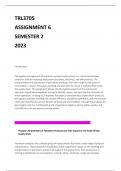TRL3705
ASSIGNMENT 6
SEMESTER 2
2023
Introduction:
The logistics management of petroleum product supply chains is a critical and complex
endeavor, with far-reaching implications for safety, efficiency, and effectiveness. The
transportation and distribution of petroleum products, from their origin to the point of
consumption, require meticulous planning and execution to ensure a seamless flow within
the supply chain. This assignment delves into the logistics aspects of the commercial
operation of petroleum pipelines, aiming to identify, assess, and describe the intricacies of
these operations. In doing so, it explores the physical characteristics of petroleum products,
the logistics activities involved, the relative efficiency of pipeline operations, and the essential
criteria for the effective service delivery of these vital commodities. Through this analysis, we
gain insights into the multifaceted world of petroleum logistics, where safety, quality, and
cost-efficiency are paramount considerations.
a) Identify the physical characteristics of petroleum product in supply chains
Physical Characteristics of Petroleum Products and Their Impact on the South African
Supply Chain
Petroleum products are a diverse group of hydrocarbons that have a wide range of physical
characteristics. These physical characteristics have a significant impact on the handling and
transportation of petroleum products throughout the supply chain, from production to
refining to distribution to consumption. In South Africa, which has a large and complex
, petroleum supply chain, it is important to understand the physical characteristics of
petroleum products in order to design and operate safe and efficient systems for moving
them.
Density
One of the most important physical characteristics of petroleum products is their density.
Density is a measure of how much mass is contained in a given volume. Petroleum products
have a wide range of densities, from lighter-than-water products such as gasoline and
kerosene to heavier-than-water products such as asphalt and bunker fuel.
The density of a petroleum product affects how it is stored and transported. For example,
lighter-than-water products can be stored in floating roof tanks, while heavier-than-water
products must be stored in tanks with fixed roofs. Lighter-than-water products can also be
transported in pipelines, while heavier-than-water products must be transported in ships or
trucks.
Viscosity
Another important physical characteristic of petroleum products is their viscosity. Viscosity is
a measure of how easily a fluid flows. Petroleum products also have a wide range of
viscosities, from thin and watery liquids to thick and sticky solids.
The viscosity of a petroleum product affects how easily it can be pumped and handled. For
example, thin and watery liquids, such as gasoline, can be pumped easily through pipelines,
while thick and sticky solids, such as asphalt, must be heated to reduce their viscosity before
they can be pumped.
Volatility
Petroleum products are volatile liquids, which means that they evaporate easily. This
volatility can be a safety hazard, as it can create flammable vapors. The volatility of a
petroleum product depends on its molecular weight and composition. For example, gasoline
is more volatile than diesel fuel.
The volatility of petroleum products must be considered in the design and operation of
storage facilities and transportation systems. For example, storage tanks for volatile
petroleum products, such as gasoline, must be equipped with vapor recovery systems to
prevent the release of flammable vapors into the atmosphere. Trucks that transport volatile
petroleum products must also be equipped with special safety features, such as fire
extinguishers and explosion-proof fuel tanks.





